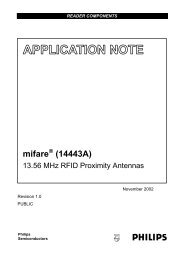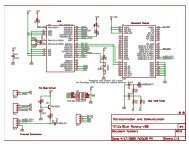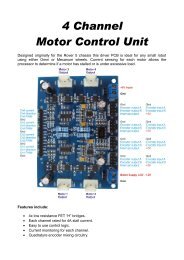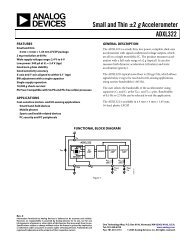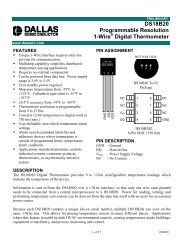u-blox 6
u-blox 6
u-blox 6
Create successful ePaper yourself
Turn your PDF publications into a flip-book with our unique Google optimized e-Paper software.
5.4 Receiver Default Configuration<br />
Permanent Configurations can be reset to Default Configurations through a UBX-CFG-CFG/clear message. The<br />
receiver's Default Configuration is determined at system startup. Refer to specific product data sheet for further<br />
details.<br />
6 NMEA Protocol Configuration<br />
The NMEA protocol on u-<strong>blox</strong> receivers can be configured to the need of customer applications using<br />
CFG-NMEA. As default all invalid positions out of the defined accuracy range are not reported.<br />
There are two NMEA standards supported. The default NMEA protocol version is 2.3. Alternatively also<br />
Specification version 2.1 can be enabled (for details on how this affect the output refer to section Position Fix<br />
Flags in NMEA Mode ).<br />
NMEA filtering flags<br />
Parameter<br />
Position filtering<br />
Masked position<br />
filtering<br />
Time filtering<br />
Date filtering<br />
SBAS filtering<br />
Track filtering<br />
Description<br />
If disabled, invalid or old position output is being communicated, but the valid flag<br />
indicates that the data is not current.<br />
If disabled, Masked position data is still being output, but the valid flag will indicate that<br />
the defined accuracy range has been exceeded.<br />
If disabled, the receiver's best knowledge of time is output, even though it might be<br />
wrong.<br />
If disabled, the receiver's best knowledge of date is output, even though it might be<br />
wrong.<br />
If enabled, SBAS satellites are reported according to the NMEA standard.<br />
If disabled, an unfiltered course over ground (COG) output is being output.<br />
NMEA flags<br />
Parameter<br />
Compatibility Mode<br />
Consideration Mode<br />
Description<br />
Some NMEA applications only work with a fixed number of digits behind the decimal<br />
comma. Therefore u-<strong>blox</strong> receivers offer a compatibility mode to communicate with the<br />
most popular map applications.<br />
u-<strong>blox</strong> receivers use a sophisticated signal quality detection scheme, in order to produce<br />
the best possible position output. This algorithm considers all SV measurements, and<br />
eventually decides to only use a subset thereof, if it improves the overall position<br />
accuracy. If Consideration mode is enabled, all Satellites, which were considered for<br />
navigation, are being communicated as being used for the position determination. If<br />
Consideration Mode is disabled, only those satellites are marked as being used, which<br />
after the consideration step remained in the position output.<br />
7 Forcing a Receiver Reset<br />
Typically, in GPS receivers, one distinguishes between Cold, Warm, and Hot starts, depending on the type of<br />
valid information the receiver has at the time of the restart.<br />
• Cold start In this mode, the receiver has no information from the last position (e.g. time, velocity, frequency<br />
etc.) at startup. Therefore, the receiver must search the full time and frequency space, and all possible<br />
satellite numbers. If a satellite signal is found, it is tracked to decode the ephemeris (18-36 seconds under<br />
strong signal conditions), whereas the other channels continue to search satellites. Once there is a sufficient<br />
number of satellites with valid ephemeris, the receiver can calculate position- and velocity data. Please note<br />
that some competitors call this startup mode Factory Startup.<br />
GPS.G6-SW-10018-A Public Release Page 16 of 201



